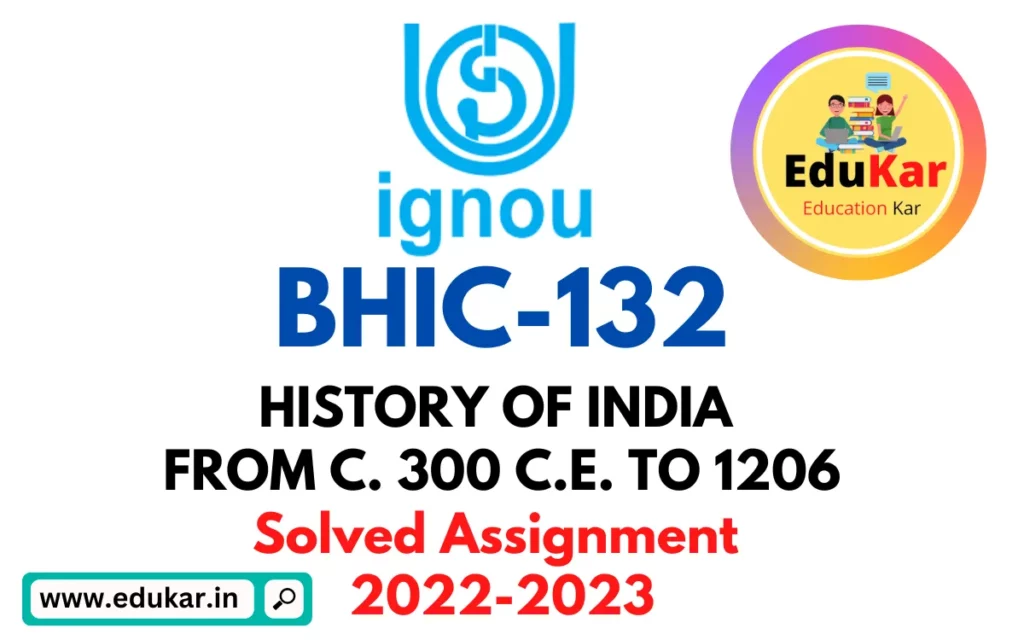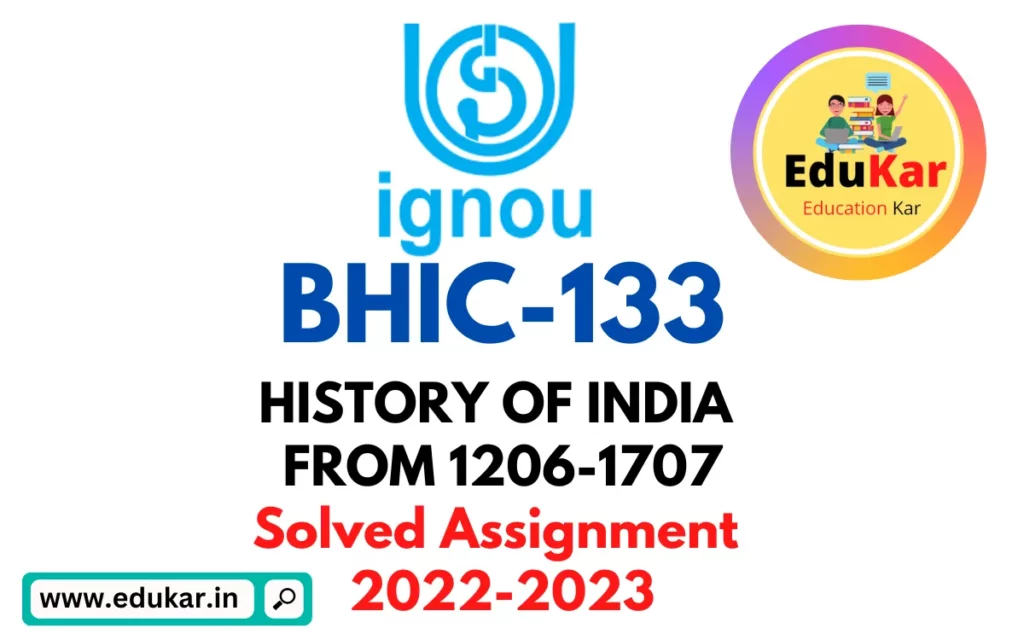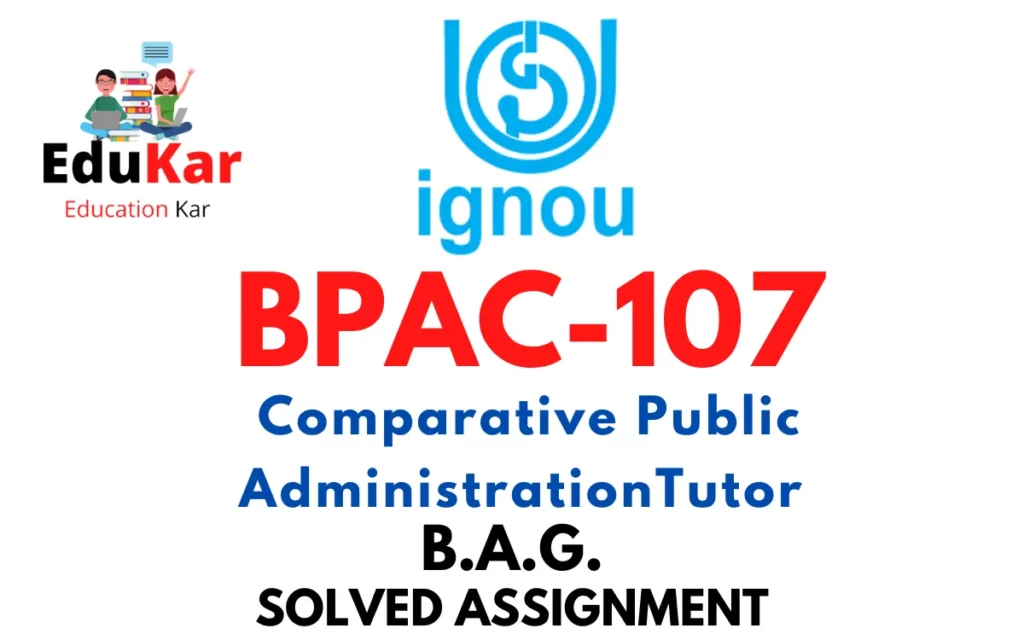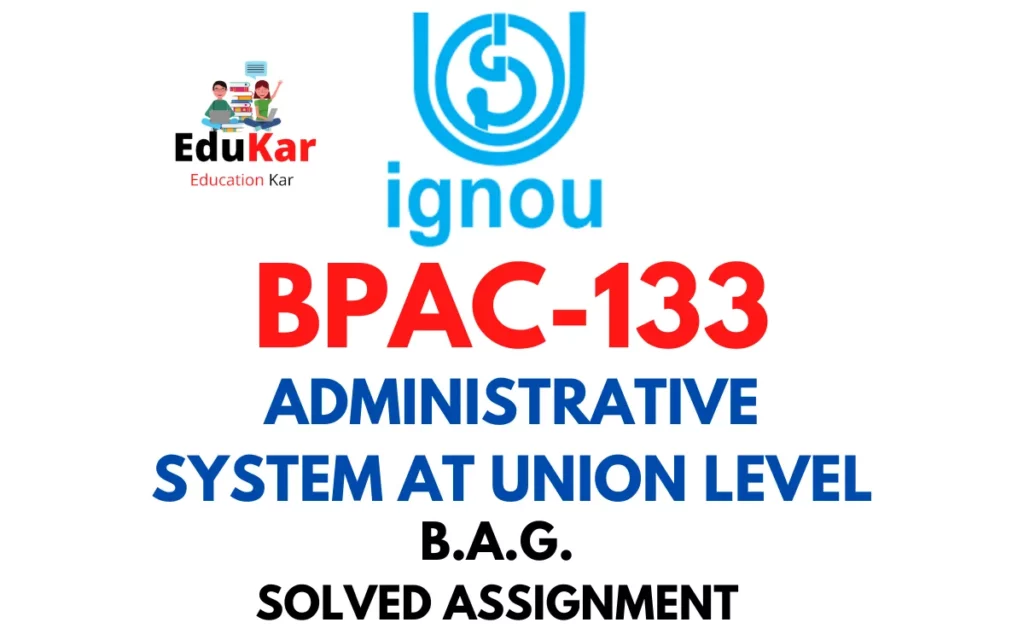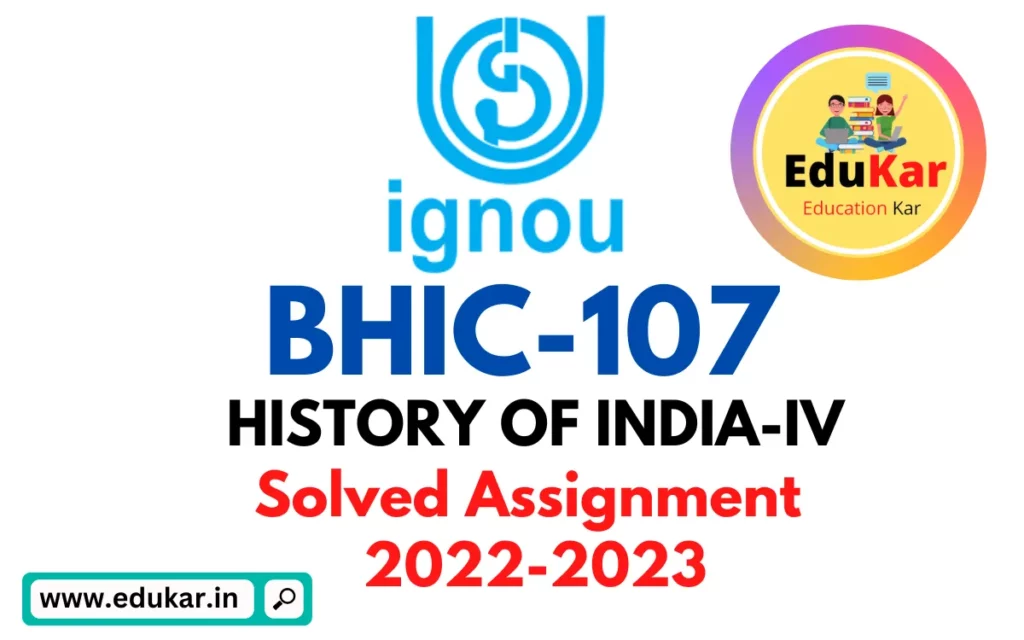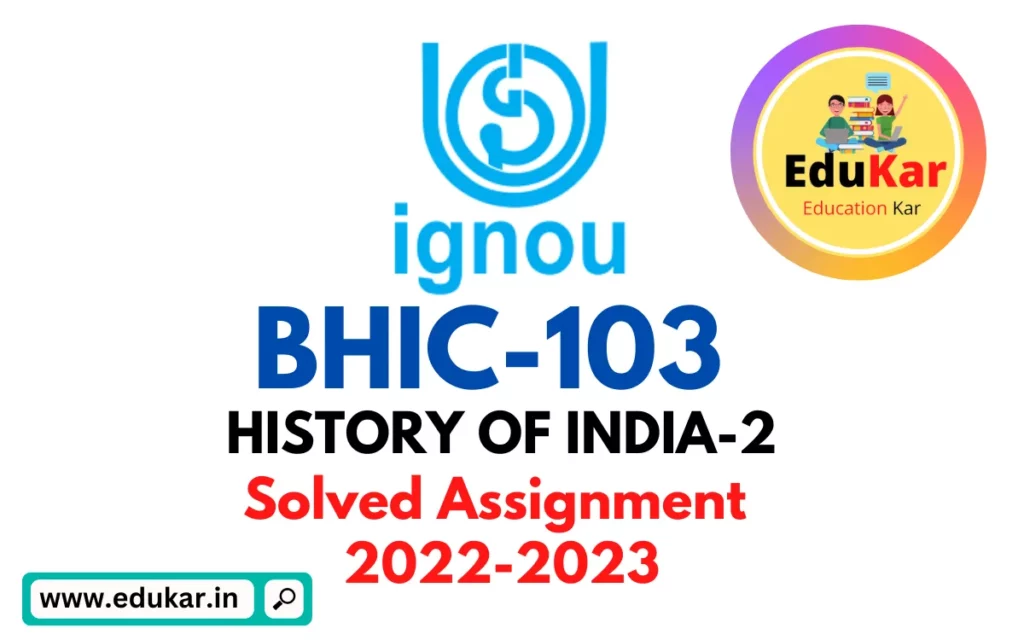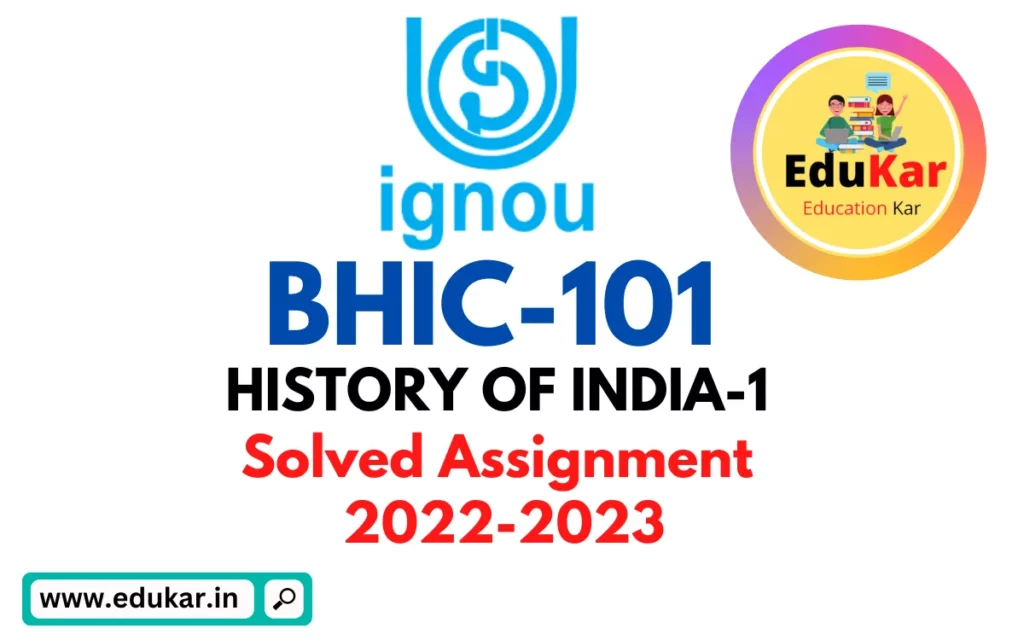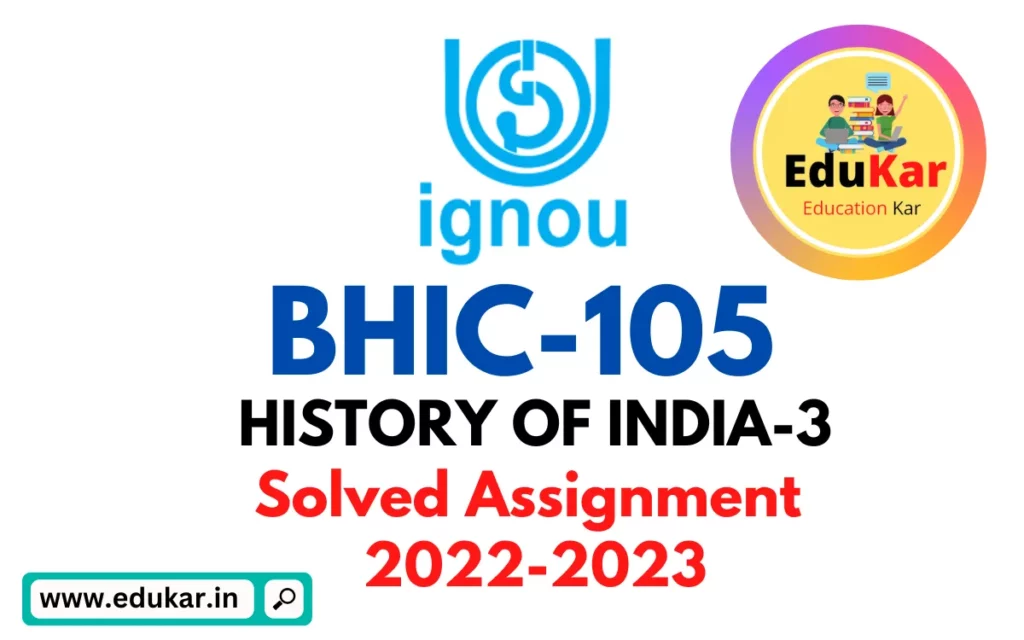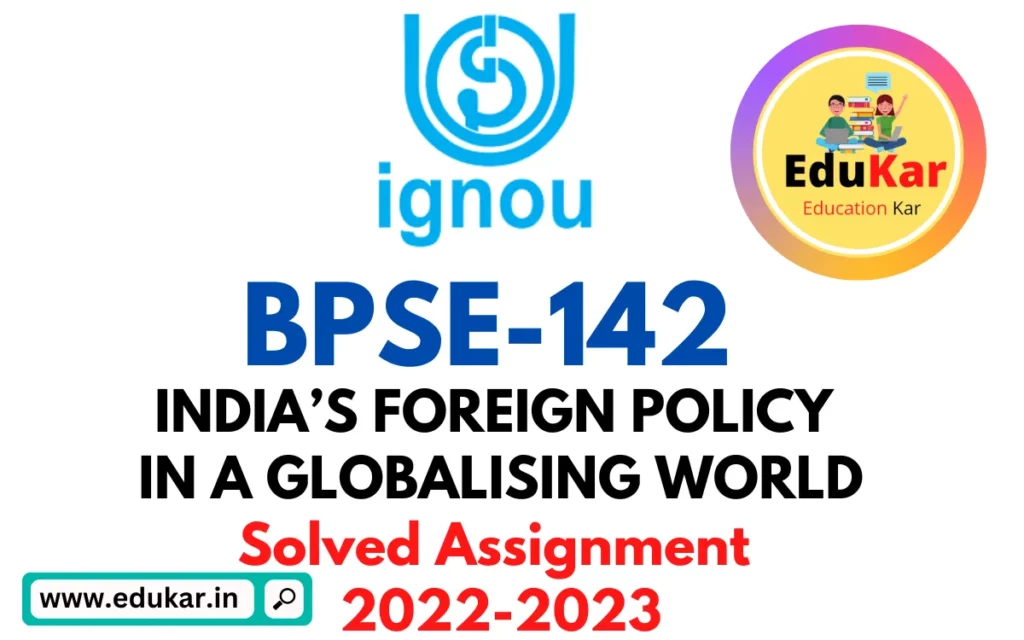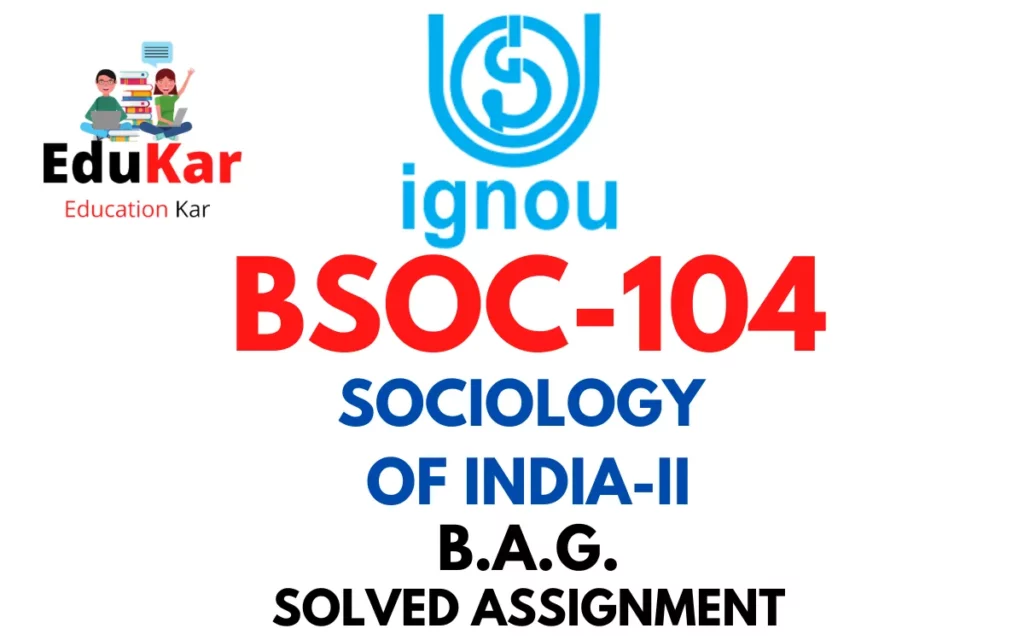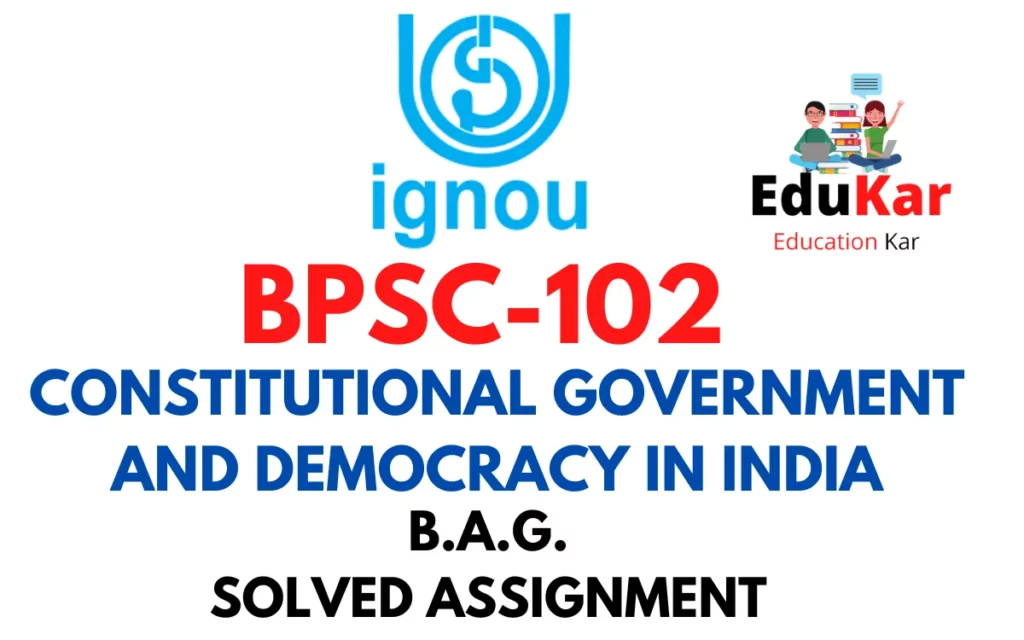Contents
- 1 Assignment A
- 2 Answer the following questions in about 500 words each.
- 3 1. Discuss the administrative system of Gupta period.
- 4 2. Describe about the organization and functions of Union Public Service Commission and Election Commission.
- 5 Assignment B
- 6 Answer the following questions in about 250 words each.
- 7 3. Highlight the changes that took place in Indian Administration post-Independence.
- 8 4. Briefly discuss the unitary features of the Indian Constitution.
- 9 5. Examine the relationship between secretariat and executive.
- 10 Assignment C
- 11 Answer the following questions in about 100 words each.
- 12 6. Write a note on Government of India Act, 1935.
- 13 7. What do you mean by Public Interest Litigation (PIL)?
- 14 8. Discuss the role and functions of Cabinet Committees.
- 15 9. Give a note on the Indian Forest Service.
- 16 10. Elaborate upon the concept of Administrative Tribunal.
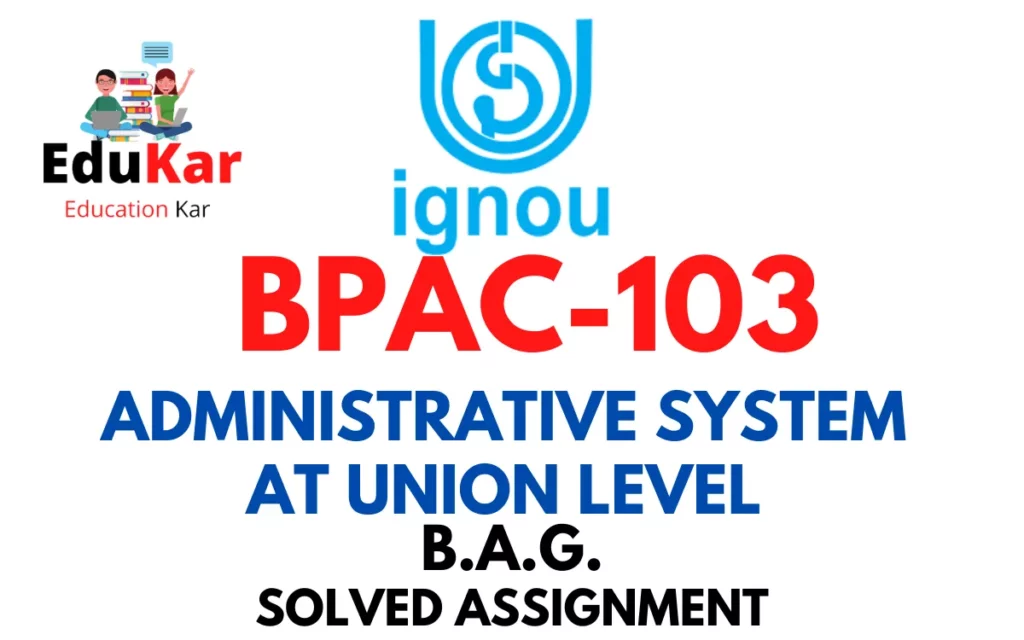
| Title | BPAC-103: IGNOU BAG Solved Assignment 2022-2023 |
| University | IGNOU |
| Degree | Bachelor Degree Programme |
| Course Code | BPAC-103 |
| Course Name | ADMINISTRATIVE SYSTEM AT UNION LEVEL |
| Programme Name | Bachelor of Arts (General) |
| Programme Code | BAG |
| Total Marks | 100 |
| Year | 2022-2023 |
| Language | English |
| Assignment Code | ASST/TMA/July 2022 & January 2023 |
| Assignment PDF | Click Here |
| Last Date for Submission of Assignment: | For June Examination: 31st April For December Examination: 30th September |
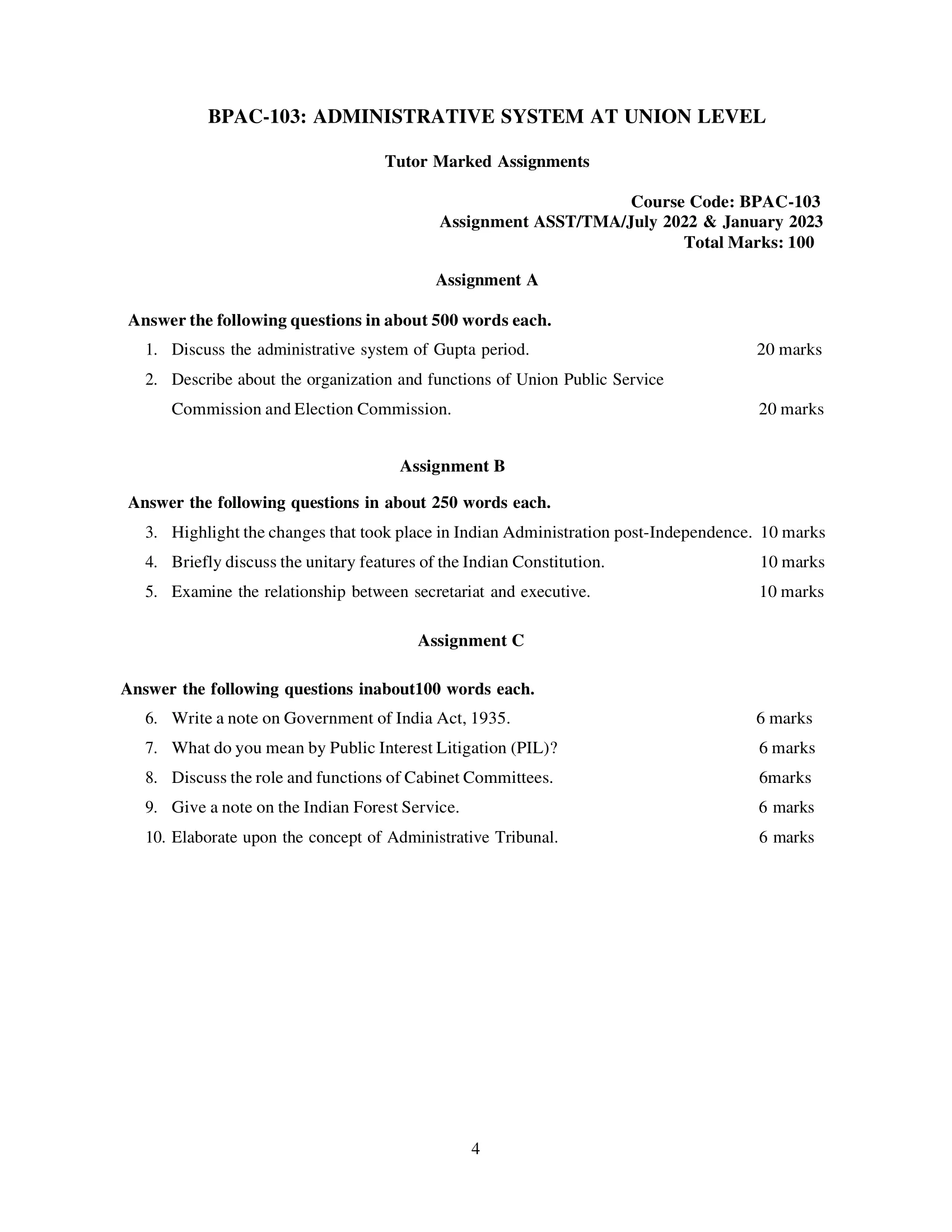
Assignment A
Answer the following questions in about 500 words each.
1. Discuss the administrative system of Gupta period.
Ans: The Gupta Empire was one of the most significant empires in ancient India, which lasted from approximately 320 to 550 CE. The Gupta administrative system was characterized by its efficiency, effectiveness, and organization. Here are some of the key aspects of the administrative system of the Gupta period:
- Centralized Administration: The Gupta administration was centralized, with the king as the head of the state. The king was assisted by a council of ministers, which included important officials such as the Prime Minister, Treasurer, Chief Justice, and Commander-in-Chief.
- Division of the Empire: The Gupta Empire was divided into provinces called Bhuktis, which were further divided into Vishayas. Each Bhukti was governed by a Bhukti-adhikari or a Governor who was responsible for maintaining law and order, collecting revenue, and protecting the people.
- Revenue System: The Gupta Empire’s revenue system was based on the land. The land was classified into three categories – Royal, Temple, and Private. The revenue was collected in the form of taxes, including land revenue, customs, and tolls.
- Military Administration: The Gupta army was divided into four divisions, each under the command of a Senapati or General. The army was equipped with elephants, horses, chariots, and foot soldiers. The emperor was the supreme commander of the army.
- Legal System: The Gupta Empire had a well-developed legal system. The laws were based on the Dharma-shastras and the decisions of the local councils. The administration of justice was done through a system of courts, which were presided over by the Chief Justice.
- Trade and Commerce: The Gupta period witnessed significant progress in trade and commerce. The administration provided protection and security to the traders, and the state collected taxes on goods transported from one place to another.
- Patronage of Arts and Literature: The Gupta Empire is also known for its patronage of arts and literature. The kings were great patrons of scholars, and they encouraged the development of literature, art, and science.
2. Describe about the organization and functions of Union Public Service Commission and Election Commission.
Ans: The Union Public Service Commission (UPSC) and Election Commission (EC) are two important constitutional bodies in India. While UPSC is responsible for conducting recruitment examinations and selecting candidates for various civil services in the country, EC is responsible for conducting free and fair elections in India. Here is a more detailed description of the organization and functions of both bodies:
Union Public Service Commission (UPSC):
- The UPSC is an independent constitutional body that was established under Article 315 of the Indian Constitution.
- Its main function is to conduct competitive exams and interviews for recruitment to various civil services of the Indian government, including the Indian Administrative Service (IAS), Indian Police Service (IPS), and Indian Forest Service (IFS), among others.
- It also advises the government on matters related to recruitment, promotion, and disciplinary actions in the civil services.
- The UPSC has a chairman and several members who are appointed by the President of India.
Election Commission (EC):
- The EC is an independent constitutional body that was established under Article 324 of the Indian Constitution.
- Its main function is to conduct free and fair elections for the Lok Sabha, Rajya Sabha, state legislative assemblies, and offices of the President and Vice-President of India.
- It also ensures that political parties and candidates follow the Model Code of Conduct and enforces laws related to elections.
- The EC has a Chief Election Commissioner (CEC) and two Election Commissioners (ECs) who are appointed by the President of India.
Both bodies are important for the functioning of Indian democracy, as they ensure that the recruitment process for civil services and elections are conducted in a transparent and impartial manner.
Assignment B
Answer the following questions in about 250 words each.
3. Highlight the changes that took place in Indian Administration post-Independence.
Ans: The independence of India from British colonial rule on August 15, 1947, marked the beginning of a new era in Indian Administration. The new Indian administration had to face a host of challenges such as poverty, illiteracy, underdevelopment, and social inequality. The country had to be rebuilt from scratch, and a new system of governance had to be established. Here are some of the significant changes that took place in Indian administration post-independence.
- Constitution: India adopted a new constitution in 1950 that provided the framework for the new administration. The constitution was drafted by a constituent assembly, and it laid down the principles of democracy, secularism, and federalism.
- Administrative Reforms: The government implemented several administrative reforms to improve the efficiency and effectiveness of the administration. The reforms included the introduction of the All India Services, the establishment of the Planning Commission, and the adoption of the Panchayati Raj system.
- Economic Planning: The Indian government adopted a planned economy to promote rapid industrialization and economic development. The government launched the First Five-Year Plan in 1951, which was followed by several other five-year plans.
- Social Reforms: The Indian government introduced several social reforms to improve the lives of the people. These reforms included the abolition of untouchability, the promotion of education, the establishment of the Green Revolution, and the promotion of family planning.
- Foreign Policy: India adopted a policy of non-alignment in its foreign policy, which meant that it would not align itself with either the Western or the Eastern bloc during the Cold War. India also played a significant role in the formation of the Non-Aligned Movement.
4. Briefly discuss the unitary features of the Indian Constitution.
Ans: The Indian Constitution is a unique blend of federalism and unitarism. While it provides for a federal system of governance, it also has certain unitary features. The unitary features of the Indian Constitution are as follows:
- Strong Centre: The Indian Constitution establishes a strong Centre with extensive powers. The Union government has the power to make laws on subjects that fall under the State List if it deems it necessary in the national interest.
- Single Constitution: Unlike in a federal system, there is only one Constitution in India that applies uniformly to the entire country. The Constitution provides for a single system of government that applies to all states.
- All-India Services: The Constitution provides for the creation of All-India Services such as the Indian Administrative Service and the Indian Police Service. These services are controlled by the Union government and operate across the country.
- Emergency Provisions: The Constitution provides for emergency provisions that can be invoked by the Centre during times of crisis. In such situations, the Centre can assume greater control over the states and centralize power.
- Unified Judiciary: The Indian Constitution provides for a unified judiciary system, with the Supreme Court at the top. The judiciary has the power to interpret the Constitution and settle disputes between the Centre and the states.
5. Examine the relationship between secretariat and executive.
Ans: The secretariat and the executive are two important branches of government, and they share a close relationship. In many countries, including India, the secretariat is responsible for providing administrative support to the executive branch. The relationship between the secretariat and the executive can be examined in the following ways:
- Administrative Support: The secretariat provides administrative support to the executive branch by performing various tasks such as drafting policies, implementing government programs, and managing budgets. The secretariat also provides advice and assistance to the executive branch on matters such as legal issues, international relations, and public opinion.
- Coordination: The secretariat also coordinates with the executive branch to ensure that policies and programs are implemented effectively. This involves working with different departments and agencies to ensure that they are working towards the same goals and objectives.
- Accountability: The secretariat is also responsible for ensuring that the executive branch is held accountable for its actions. This includes providing reports on the implementation of policies and programs, monitoring the performance of the executive branch, and providing feedback on areas that need improvement.
- Conflict Resolution: The secretariat may also act as a mediator between different departments within the executive branch to resolve conflicts and disagreements. This helps to ensure that policies and programs are implemented effectively, and that the government is functioning smoothly.
Assignment C
Answer the following questions in about 100 words each.
6. Write a note on Government of India Act, 1935.
Ans: The Government of India Act, 1935 was a significant legislation that laid the foundation for the constitutional framework of independent India. It was the longest and most comprehensive act passed by the British Parliament for the governance of British India.
The Act provided for the establishment of a Federation of India, consisting of provinces and princely states, with a federal government at the center. It also introduced the concept of provincial autonomy and the formation of autonomous provinces.
The Act gave the right to vote to a larger number of people, including women and tenants, and provided for the establishment of a Federal Court and a Reserve Bank of India. It also extended the franchise and introduced separate electorates for minorities.
The Government of India Act, 1935, however, did not come into full effect as India gained independence in 1947. However, it provided the basis for the Indian Constitution that was adopted in 1950.
7. What do you mean by Public Interest Litigation (PIL)?
Ans: Public Interest Litigation (PIL) is a legal mechanism that allows any citizen or group of citizens to approach the court for the enforcement of public rights, protection of public interest, and prevention of violation of legal or constitutional rights. It is a type of litigation that is not filed for personal gain, but to ensure justice and equality for all members of society.
PILs are usually filed in the higher courts, such as the Supreme Court and High Courts, and have been used to address a wide range of issues, including corruption, human rights violations, environmental degradation, and discrimination against marginalized communities.
PILs have become an important tool for promoting social justice and holding the government and its agencies accountable for their actions. They provide a means for citizens to participate in governance and help ensure that the government works for the benefit of all citizens.
However, it is important to note that PILs should not be misused for personal or political gain, and the courts have the power to dismiss frivolous or motivated PILs.
8. Discuss the role and functions of Cabinet Committees.
Ans: Cabinet Committees are committees formed by the Cabinet of Ministers in India to address specific policy issues and make recommendations to the Cabinet. These committees are headed by a Cabinet Minister and include other senior Cabinet Ministers as members.
The following are some of the roles and functions of Cabinet Committees:
- To assist the Cabinet: The Cabinet Committees are formed to assist the Cabinet in making decisions on important policy matters by conducting in-depth discussions and analyses of various options and making recommendations to the Cabinet.
- To coordinate policy: Cabinet Committees help in coordinating policy across different ministries and departments by bringing together representatives from various departments to discuss and resolve inter-departmental issues.
- To monitor and review policy implementation: The Cabinet Committees also play a role in monitoring and reviewing the implementation of policy decisions taken by the Cabinet.
- To provide expertise and advice: Cabinet Committees may invite experts from outside the government to provide advice and expertise on specific policy issues.
- To address emergency situations: In cases of emergency, the Cabinet Committees can be quickly convened to make decisions and take action.
Some of the important Cabinet Committees in India include the Cabinet Committee on Economic Affairs, Cabinet Committee on Security, Cabinet Committee on Political Affairs, Cabinet Committee on Accommodation, and Cabinet Committee on Investment and Growth.
9. Give a note on the Indian Forest Service.
Ans: The Indian Forest Service (IFS) is one of the three All India Services of the Government of India, alongside the Indian Administrative Service (IAS) and the Indian Police Service (IPS). The IFS was created in 1966 and is responsible for managing the country’s forests, wildlife, and protected areas. The service is headed by the Director General of Forests and is part of the Ministry of Environment, Forests and Climate Change.
The primary role of the IFS is to implement the National Forest Policy and the Wildlife Protection Act, and to promote sustainable management of forests and wildlife resources. IFS officers are responsible for managing national parks, wildlife sanctuaries, and other protected areas, as well as implementing programs related to afforestation, forest conservation, and rural development.
IFS officers are selected through a competitive examination conducted by the Union Public Service Commission (UPSC). They undergo extensive training in subjects such as forestry, wildlife conservation, environmental management, and rural development before being posted to various parts of the country.
The IFS is an important component of India’s environmental management and conservation efforts. It plays a crucial role in the protection and management of the country’s forests, wildlife, and biodiversity. The service has contributed significantly to the establishment and management of protected areas and has played an important role in the conservation of endangered species such as the tiger and the elephant.
10. Elaborate upon the concept of Administrative Tribunal.
Ans: Administrative Tribunals are specialized courts that have been established to provide a more efficient and effective mechanism for resolving disputes related to the administration of government programs and services. These tribunals are designed to be less formal and more flexible than traditional courts, allowing them to deal with complex administrative issues in a more efficient and timely manner. They are typically staffed by experts in the area of law or policy that is being addressed, and they have the power to make binding decisions on disputes that fall within their jurisdiction. Administrative Tribunals play an important role in the justice system by providing a specialized and accessible forum for resolving administrative disputes.
How to Download BPAC-103 Solved Assignment?
You can download it from the www.edukar.in, they have a big database for all the IGNOU solved assignments.
Is the BPAC-103 Solved Assignment Free?
Yes this is absolutely free to download the solved assignment from www.edukar.in
What is the last submission date for BPAC-103 Solved Assignment?
For June Examination: 31st April, For December Examination: 30th October

